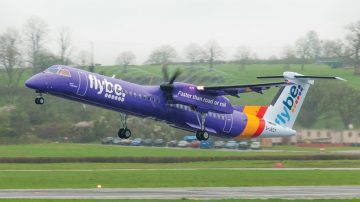
British owned and built, the Britten-Norman Islander transports passengers around some of the most exotic locations on earth, reports Andrew Eames.
In the world of aviation fleet management, it’s all about maximising revenue. Seat configurations, range extension, fuel economy, noise reduction… these are the issues that keep an airline CEO awake at night. But not all airlines have the same issues. There are other priorities for those that operate in some of the most wonderful, and exhilarating, parts of the world. Airlines that connect tropical islands, for example. And airlines that commute between African hubs and the bumpy unmetalled strips of safari country.
Airlines such as Loganair, which operates the shortest scheduled flight in the world – the two minutes between Westray and Papa Westray in the Orkneys. Or Barrier Air, commuting between Auckland and Great Barrier Island in New Zealand. Or Fly Montserrat, which connects the volcanic Caribbean island of Montserrat with the outside world.
These carriers have a few key things in common: they run essential services in places where facilities are few, but the rewards – scenically – are sky high. And they all use one particular veteran aircraft that has a particularly doughty reputation: the Britten-Norman Islander.
The Islander has been described as the “Land Rover of the skies” because of its ability to operate in challenging conditions. In the Orkneys, for example, when the weather cuts up rough and the inter-island ferries seek shelter, the Islander still does its circuit, although it’ll be a bumpy ride.
British heritage
Like the Land Rover itself, the Islander is strongly associated with Britain, and it has been for the last 53 years. Britten-Norman is the only remaining privately owned civil aircraft manufacturer based in the UK, and its aircraft are still assembled according to a design first drawn up in 1963. Mainstream aviation may be fast changing, but in the world of the Islander, much stays the same.
John Britten and Desmond Norman started the company 64 years ago. Their original intention was to create a slow-flying, low-maintenance crop duster that could cope with a lifetime of taking off and landing on unprepared tracks, and that could do so without shaking itself to pieces. The Islander went into production at Bembridge on the Isle of Wight, where its proprietary components are still made; though the airframe assembly is partly done in Romania (as it has been for 50 years), and then completed in Britten-Norman’s large hangar at Solent Airport in Fareham, Hampshire.
In the course of the company’s half-century of existence this production line has turned out some 1,300 Islanders, of which a staggering 700 are thought to be still in service – although getting exact figures is hard for an aeroplane whose natural habitat is remote places.
Not every passenger will relish being told that the plane they’re flying in is substantially older than them, but then the eyes of the (up to nine) passengers who clamber aboard are not going to be lingering on the wear and tear of the seat trim or the glossiness of the in-flight magazine. Instead, they’ll be bewitched by the pilot turning in his seat to deliver the safety talk, by the cockpit dials laid out in plain view, and by the carpets of land and sea that unravel beneath the wings.
The guiding principles of the aircraft have always been simplicity and durability. Treated right, nothing wears out – except perhaps the seat covers – which creates a conundrum for a company that wants to sell aircraft. “Our number one competitor is an older Islander,” admits William Hynett, Britten-Norman’s chief executive, because the demand for new aircraft is massively reduced when there are still perfectly good old ones out there. There were times in the 1970s and 1980s when ten aircraft were in the BN production line simultaneously, but these days new-builds are down to three or four a year. Instead, servicing, refurbishing, adapting and supplying parts provides a growing part of the company’s turnover of around £12 million per annum – along with a substantial contract with the Ministry of Defence.
The personal touch
A great many of the newer Islanders – some 498 – have passed through the hands of one man, Pete Dowers, who has supervised construction for the past 40 years. Dowers still has the original design drawings as his guide, and he’s overseen a long list of modifications for bespoke aircraft, from cocktail cabinets to glass floors. As the person who signs off the final product he has to run a tight ship: “You need to make sure that every tool that goes on-board during assembly comes out again; when you’re up in the sky there’s no pulling over onto the hard shoulder to see what’s rattling.” And does he keep tabs on all the aircraft he builds? “I try not to. It really upsets me to see one crash.”
As for William Hynett, he’s pretty hands-on himself. Besides the responsibilities of running a company of 160 employees, he’s also a pilot and personally gets involved in delivering, or retrieving, Islanders from far-flung places. En route, he often takes the opportunity to drop in on customers past and present.
These trips are not always straightforward. Hynett tells the story of bringing an aircraft back from Florida via Greenland, with an extra fuel tank behind the pilot to increase the flying range. “Normally in these situations the tank fitters block off the heating duct under the tank, but when the weather really started to get cold I could smell burning rubber. It hadn’t been blocked.” So he had to turn the heating off, and complete the rest of the journey wearing a sleeping bag. In the world of the Islander, you have to be prepared to improvise.












